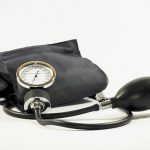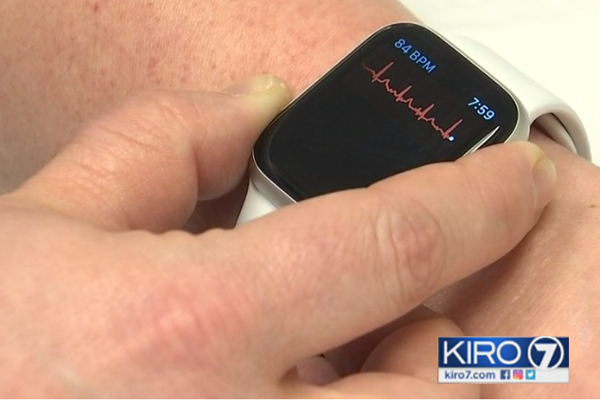Everyday habits for a healthy heart
Heart Health Month may be done, but here are some tips that can help all year-round.
Heart disease is the leading cause of death for both men and women, according the Centers for Disease Control and Prevention.
While we bring attention to heart health nationwide every February, everyday habits can lead to a healthier heart year-round. It’s important that Americans not only take advantage of quality health care, but also take steps to control their blood pressure and strengthen their hearts.
Here are a few actions everyone can take:
Eat healthy: Diet is a key factor to overall heart health. While it’s ok to indulge every now and then, whole grains, fruits and vegetables should make up the bulk of your meals to ensure you’re receiving the appropriate vitamins and minerals. Generally, it’s best to avoid or minimize refined grain products (such as white bread, pasta and pastries), unhealthy fats like saturated and trans fats, and sodium. Tips to help with this include swapping for monounsaturated fats or polyunsaturated fats like olive, fish, avocado, nut, and seed oils; eating freshly prepared foods, as restaurants tend to have a heavy hand with the salt shaker; and controlling portion sizes, using a small plate or bowl to avoid the temptation to overeat.
Exercise: The American Heart Association recommends a total of 150 minutes of exercise per week, including muscle-building activities like resistance or weight training at least two days per week. Although many of us are tied to desks day after day, it’s important to remember that any amount of exercise is better than none. If you spend most of your day sitting, set a timer a few times a day to remind yourself to get up and move. This can be as simple as a walk around the office or neighborhood, or even a few stretches on the floor. A quick consultation with your primary care provider can help craft an exercise routine best for you.
Sleep: A lack of sleep can lead to a number of long-term health issues, including an increased risk of cardiovascular and coronary heart disease. It’s vital to try and achieve at least eight hours of sleep per night. Establishing a sleep schedule, getting regular exercise and avoiding caffeine and alcohol late in the day can help you get more hours at night.
Stop smoking: Tobacco and nicotine in all forms are dangerous for overall cardiovascular health and should be avoided entirely. Even one cigarette a day can be detrimental to your health, as can e-cigarettes. The good news is that it’s never too late to stop and your doctor can provide tips and resources to help you along the way.
While Heart Health Month is over, you can still celebrate with a visit with your primary care provider or cardiologist to review your medical history, check your cholesterol and blood sugar levels and determine your risk. I encourage everyone to be informed, take control of their health and make lifestyle changes for a strong and healthy heart for years to come.
Keeping your body healthy in the office
 If you work in an office setting, you may find yourself with tension, stiffness, and muscle aches. Sitting at a desk for long periods of time can have negative impacts on your body. However, there are several easy tips you can implement in your daily routine to prevent these issues.
If you work in an office setting, you may find yourself with tension, stiffness, and muscle aches. Sitting at a desk for long periods of time can have negative impacts on your body. However, there are several easy tips you can implement in your daily routine to prevent these issues.
WORKSTATION ERGONOMICS
Have your mouse and keyboard within close reach, and your chair fully supporting your back. Thighs should be horizontal, and feet firmly planted on the floor. If needed, place a small stool under your feet. The top one third of your computer screen should be at eye level, and if you have multiple screens, have them close together.
MOVE
If you sit most of the day, stand and move for 5-15 minutes of every hour. If you have a standing desk, stand up for 2-4 hours of your workday. Standing in place can also lead to back and leg discomfort, so continue to take movement breaks once each hour.
STRETCH
Incorporate simple stretches into your day, holding for 20-30 seconds each:
- Back extension: Reach your arms overhead, arch backwards, and look up at the ceiling.
- Side-bend: Place one arm on your thigh or the armrest of your chair, keep both feet planted on the ground, and reach overhead to the opposite side.
- Hamstring: Sit at the edge of your chair and extend one leg forward with your knee straight. Hinge forward at the waist, keeping your back straight until you feel a stretch in the back of your leg.
- Upper trap: Sit or stand up straight, then bring one ear toward the same shoulder. Keep your eyes and nose forward. Repeat on the other side.
- Shoulder blades: Sit tall and squeeze your shoulder blades together and down.

Apple Watch helps save the life of a man with heart issues
February is American Heart Month and KIRO 7 is looking at advances in life-saving treatment here in Western Washington.
Heart disease is the leading killer in both men and women. But new heart monitoring technology in the Apple Watch helped save a Bothell man’s life.
Cardiologist Dr. Phil Massey of Pacific Medical Centers in Seattle showed KIRO 7 the advancements in preventing heart disease related deaths. That included the Apple Watch and its ability to detect atrial fibrillation, or a-fib, which is an irregular, fast heartbeat.
Mediterranean Diet Rated “Best Diet”
 On January 2, US News and World Report unveiled the Mediterranean diet as its Best Overall Diet for 2019. In addition, the Mediterranean diet also came in first for easiest diet to follow, best diet for healthy eating, best diet for plant-based eating and best diet for diabetes. Learn more in this CNN article.
On January 2, US News and World Report unveiled the Mediterranean diet as its Best Overall Diet for 2019. In addition, the Mediterranean diet also came in first for easiest diet to follow, best diet for healthy eating, best diet for plant-based eating and best diet for diabetes. Learn more in this CNN article.
The health of Mediterranean nutrition is no surprise. Numerous studies have shown that Greeks, Italians, French and Spaniards along the Mediterranean coast often live long, healthy lives. Meals from the sunny region have been linked to reduced risk for high cholesterol, diabetes, dementia, depression, memory loss and breast cancer. The diet has also been found to support weight loss, strong bones and a healthy heart.
The Mediterranean diet is a pattern of eating, not a structured diet. It has no rigid rules and offers lots of choice and variety. It even promotes a glass of red wine and the occasional treat! Many call it a lifestyle, with frequent socializing over meals, mindful eating and daily exercise such as walking.
Meals emphasize simple cooking and include lots of vegetables, fruits, whole grains, seeds, beans and legumes. Dishes lean heavily on olive oil and flavorful herbs and spices, and fish and seafood are eaten at least twice a week. Poultry, eggs, cheese and yogurt are enjoyed in moderation. Sweets and red meat are saved for special occasions. Finally, red wine and plenty of water round out the diet.
Check out this sample one-day menu to whet your appetite. “Buon appetito! Kalí órexi! ¡Buen provecho! Bon appétit!”
The Living Well Alliance is run by Pacific Medical Centers. Call us today at 206.621.4419 for more information or email LivingWellAlliance@pacmed.org
.
*Some patient names in this publication have been changed for privacy.
Recipe: Caramelized Beet and Sweet Onion Soup
Beets are rich in nutrients, including folate and potassium. They also have a high nitrate content, which has been studied for its heart-healthy benefits and ability to lower blood pressure.
Nutrition Tips for Healthy Blood Pressure Numbers
 February is heart health month! You can do a lot to prevent heart disease, and one of the best ways is to get control over your blood pressure. High blood pressure is diagnosed when the force of the blood flowing through your blood vessels is consistently too high, meaning over 140/90 mmHg. These two numbers demonstrate the pressure of blood flowing through your blood vessels. Unfortunately, a high amount of pressure over a long time can cause damage or changes to the important vessels, increasing the risk for heart attack or stroke.
February is heart health month! You can do a lot to prevent heart disease, and one of the best ways is to get control over your blood pressure. High blood pressure is diagnosed when the force of the blood flowing through your blood vessels is consistently too high, meaning over 140/90 mmHg. These two numbers demonstrate the pressure of blood flowing through your blood vessels. Unfortunately, a high amount of pressure over a long time can cause damage or changes to the important vessels, increasing the risk for heart attack or stroke.
If you have high blood pressure, here are three ways to start:
- Ask for help. First, talk to your doctor about possible medications to control blood pressure. There are many different kinds depending on your unique body. While most of us don’t like taking medications, they do have their place in bringing your blood pressure numbers into a normal range fairly quickly. The benefits far outweigh the damage that can accumulate in your body without this swift control. Of course, medication isn’t the only thing you should focus on; nutrition and exercise are close second and third steps.
- Eat smart. You also need to review any dietary habits that can contribute to high blood pressure. The first two places to focus on are reducing excess sodium and eating more vegetables. Sodium is directly linked to increasing blood pressure over time. Aim for less than 2400mg of sodium per day (or about 1 teaspoon). Foods with high sodium include fast foods, soups, pizza and cheesy foods. Second, increasing vegetables in your diet to 5-7 servings per day means your body gets more potassium and other nutrients that help manage blood pressure. Some good choices are sweet potatoes, kale and avocados. Additionally, foods that have high amounts of nitric oxide (beets, spinach, celery) help lower blood pressure by improving vascular function and blood flow. How do you start? Track your salt and vegetable intake on paper or with an app like myfitnesspal.com to meet these recommendations. Want more information? Read about the DASH diet.
- Exercise. Exercise is critical to keeping your blood pressure in range. Aim for 150 minutes per week of moderate-intensity movement, paired with some strength exercises. At a loss for ideas? Try walking during your lunch break, stretching at your workstation, walking your dog (or a neighbor’s!) or trying an exercise class at your local gym or community center.
Teamwork Can Boost New Year’s Resolutions
January is over, and those resolutions are fading. It’s amazing how quickly our resolve dissolves. The problem, according to two PacMed physical therapists (PTs)—who have decades of experience walking people back from devastating setbacks—could be trying to change all on your own.
When PacMed’s Aysha Morgan, PT, DPT, first met Sandy,* she’d “had a very severe stroke a few years ago and was only being pushed around in a wheelchair…. She felt the only thing she could do was move one arm. She couldn’t stand, she couldn’t transfer, she definitely couldn’t walk.”
“I took one look at her, and I thought, ‘No, no, no—there’s potential in this woman!’” says Aysha. “Let’s see what kind of potential you have that’s going to make your life easier.” Over the course of the year, Aysha worked with Sandy, helping her stand, then take a step, then two steps and finally walk with a cane.
When our beliefs keep us from changing, it helps to connect with someone else who sees our potential—like Aysha did for Sandy. Stephanie Clements, PT, who manages PacMed’s team of 15 physical therapists, encourages the team to see potential by keeping the whole person in mind. “Once you find out more about them, then they start to tell you more about what they’re capable of doing, or what their dream is to do…. You’re more than your diagnosis,” she says.
Stephanie sees the best outcomes among people who make social connections part of their health routine: “The ones that do very well are the ones that go to the community center three times a week. So they’ve got a group… it’s socializing. They are in the same boat; they are all wanting the same thing.”
To read more about this approach to change, visit www.PacMed.org/resolutions.
Love Your Heart This Valentine’s Season
 Put Your Heart First This Valentine’s Season
Put Your Heart First This Valentine’s Season
What’s on your Valentine’s Day list this year? A dozen red roses? A box of gourmet chocolates? A romantic getaway or tickets to the big game? These excellent choices may cause hearts to flitter—a great reminder that with all the love going around, our hearts need love, too!
As one in four deaths are caused by heart disease, American Heart Month in February is a great time for some uplifting activities that our hearts can fall in love with.
Ask your heart to dance
It’s not always easy to exercise in winter, so why not get creative? Bust a move and clean your house to music. Try your hand at an indoor climbing wall. Play laser tag with the kids. Go ice skating, or try yoga, Pilates or water aerobics. As you dance about, remember that signs of heart attack vary for men and women; if you don’t feel quite right, be sure to seek care.
Take your heart to dinner
Love with every “fiber” of your being—by keeping fiber and whole grains in your meals! High-fiber diets have been shown to lower blood pressure and encourage a healthy weight. (While we’re on the topic of fiber, February is a great time to schedule your colonoscopy!)
Find a partner your heart can trust
Every heart has a story to tell. When it comes to choosing health care providers, let your heart in on the decision. PacMed’s team features some of the longest-serving doctors in the region, who invest in doing right by patients over the long haul.
If you’re looking for someone new, drop in for a visit—including our state-of-the art Nuclear Cardiology department at our First Hill clinic, led by Dr. Philip Massey and assisted by Dr. Keiko Aikawa.
In Remembrance of Dr. Oren Traub

It is with great sadness that we announce the passing of our great friend and valued hospitalist colleague, Dr. Oren Traub.
Dr. Traub was an accomplished physician, scientist, and writer. He earned a PhD in the field of pathology, biochemistry, and molecular biology and an MD from the University of Washington Medical School, where he was inducted into the AOA Honor Society and recognized with the James W. Haviland Award for Clinical Excellence and Leadership in Medicine. He was the recipient of several national research fellowships, Young Investigator awards, and national awards for Excellence in Research. Dr. Traub completed his residency in Internal Medicine at the University of Washington and is board-certified by the American Board of Internal Medicine.
Dr. Traub joined Pacific Medical Centers in 2004 immediately after completing his residency. He was an integral part of the Pac Med Hospitalist Team, where his professionalism was only surpassed by his vast intelligence and gentle kindness. He was a shining star who was committed to his patients and supportive of his coworkers and always could be counted upon to give his best. He would routinely stay after to assist on busy days, volunteer to cover coworkers’ requests for time off, and continue to care for patients even on his time off, often reviewing records in order to assist in improving patient care. When not providing clinical services to hospitalized patients, Dr. Traub also dedicated his professional time to medical writing, editing, and consulting.
Dr. Traub was not only an outstanding physician, but a wonderful person, and a valued friend whose joie de vivre was apparent during any interaction with him. Dr. Traub’s personal interests included travel, fantastic foods, writing, technology, live performance and politics. Dr. Traub enjoyed life and chose the best unabashedly – in his travels he enjoyed the finest of lodgings, foods, and events and shared that love with his friends
Dr. Traub is survived by his husband Mark, his parents, Tamar and Amos, and his sister, Donna. He will be sorely missed by his PacMed family and our hearts and prayers go out to his family and friends and the patients that loved him.
A memorial service for Dr. Traub will be held on Friday, April 19, 2019 from 6-8 PM at Swedish Medical Center, Cherry Hill in the Education & Conference Center, Rooms A&B.












